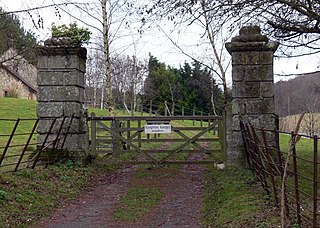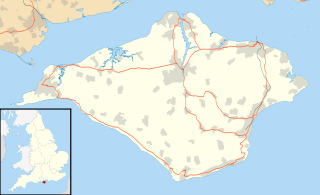
Sandown is a seaside resort and civil parish on the south-east coast of the Isle of Wight, United Kingdom with the resort of Shanklin to the south and the settlement of Lake in between. Together with Shanklin, Sandown forms a built-up area of 21,374 inhabitants.

Shanklin is a seaside resort and civil parish on the Isle of Wight, England, located on Sandown Bay. Shanklin is the southernmost of three settlements which occupy the bay, and is close to Lake and Sandown. The sandy beach, its Old Village and a wooded ravine, Shanklin Chine, are its main attractions. The esplanade along the beach is occupied by hotels and restaurants for the most part, and is one of the most tourist-oriented parts of the town. The other is the Old Village, at the top of Shanklin Chine. Together with Lake and Sandown to the north, Shanklin forms a built up area of 21,374 inhabitants (2011).

Shorwell is a village and civil parish on the Isle of Wight, United Kingdom. It is 4+1⁄2 miles (7.2 km) from Newport in the southwest of the island. Shorwell was one of Queen Victoria's favourite places to visit on the Isle of Wight.

Lake is a large village and civil parish located on Sandown Bay, on the Isle of Wight, England. It is six miles south-east of Newport situated between Sandown and Shanklin, and 1+1⁄2 miles (2.4 km) to the east of the hamlet of Apse Heath.

HMSEurydice was a 26-gun Royal Navy corvette which was the victim of one of Britain's worst peacetime naval disasters when she sank in 1878.

Knighton Gorges Manor was one of the grandest manor houses on the Isle of Wight. Located in the hamlet of Knighton, near Newchurch, it is reported to be one of the most haunted locations on the Isle of Wight.

Nunwell House, also Nunwell Manor, is a historic English country house in Brading, Isle of Wight. Located 3 miles (4.8 km) south of Ryde, the Tudor and Jacobean style house also has later additions. The house contains family militaria. It was occupied by the Oglander family from Norman times until 1980. Nunwell House is a Grade II* listed building.

Gatcombe House is a manor house in Gatcombe on the Isle of Wight, England. The original building was constructed by the Stur (Estur) family as noted in the Domesday Book. St. Olave's Church, built next to the manor to serve as its chapel, was dedicated in 1292. It also belonged at one time to the Lisles of Wootton.
Cleaveland Manor is a manor house on the Isle of Wight, situated within the Victoria parish.
Merston Manor is a manor house in Merstone on the Isle of Wight, England. The manor was first mentioned in the Domesday Book. Prior to the Norman Conquest, Merston Manor was owned by the Brictuin family. The present home, built in 1605 in the Jacobean style by Edward Cheeke, was rebuilt in the Victorian era. This structure may be the oldest brick house on the Island. The manor now belongs to the Crofts family.

Wolverton Manor is a manor house in Shorwell, on the Isle of Wight, England. The original house was started by John Dingley, Deputy Governor of the Isle of Wight. The Jacobean style home, built by Sir John Hammond after the death of Sir John Dingley, is the second house built on the site. There is a two-storey porch which features a flat roof and hollow angle columns.

Westcourt Manor is one of three manor houses, along with Woolverton and Northcourt, that is located in Shorwell, on the Isle of Wight, England. According to the Domesday Book, it was part of the possessions of Gozehne Fitz Azor, and had been held in the time of the Edward the Confessor by Ulnod in abeyance. At the time of the countess Isabella's record, we find that Sir John Lisle had this manor, with many others, which he held of her in capite, or by knight's service. It was possessed by Colonel Hill. An Elizabethan manor, it is connected to a farm of 200 acres.
Milton Manor is a manor house in the parish of Brading on the Isle of Wight, in England.
Hardley Manor was a manor house in the parish of Brading on the Isle of Wight.
Blackpan Manor is a manor house in the parish of Brading on the Isle of Wight.
Hill Manor is a manor house in the parish of Brading on the Isle of Wight.
Lee Manor is a manor house in the parish of Brading on the Isle of Wight.
Sandown Manor is a manor house in the parish of Brading on the Isle of Wight.
Scotlesford Manor was a manor house in the parish of Brading on the Isle of Wight.
Luccombe Manor was a manor house on the Isle of Wight, situated in the parish of Bonchurch.










